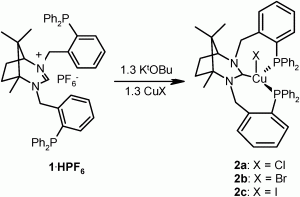Tragedies such as the thalidomide scandal led to a re-think as to how pharmaceutical drugs are tested and examined before their sale to the public. Prior to this, racemic mixtures were often administered yet sometimes only one enantiomer of the compound gave the therapeutic properties while the other caused serious side effects. For this reason, huge interest developed in controlling reactions so that only enantiomer would be formed – not a trivial task for the many millions of molecules tumbling around in a round bottom flask! Such is the significance of this problem that the 2001 Nobel Prize for Chemistry was awarded to Sharpless, Noyori and Knowles for work in this field.
Many of the methods to obtain this selectivity focus on controlling the orientation of the molecule by building a bulky pocket around the reaction site. Doing so means a reaction can only occur on one side and, as a result, only one enantiomer is created. While this technique has been shown to work well, an alternative approach is to create a reaction site which itself can control the orientation of the molecule. It is exactly this that Paul Newman, Kingsley Cavell and Benson Kariuki at Cardiff University have achieved.
The idea behind the concept is that the reaction site itself is a more efficient way of transferring the control of the chirality. To do this they have created a ‘chiral-at-metal’ Cu(I) complex (Figure 1) which is itself very rare due to the instability of these types of compounds. The characterisation of such an exciting complex is certainly worthy of rapid communication but I hope to see further papers on this work in the near future, giving us an insight into how well this complex performs as a catalyst and how effective it is at transferring chirality. Over time, the catalyst will surely undergo many subtle alterations to improve its performance but only time will tell if this is truly going to be the most effective method of controlling chirality.
Keen to read more? Download this ChemComm article here.
Posted on behalf of Ruaraidh McIntosh, Chemical Communications web writer.











